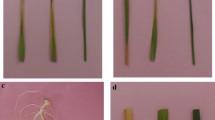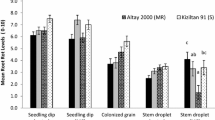Abstract
Fusarium graminearum is a common agent causing Fusarium head blight (FHB) on wheat throughout the world. Aggressiveness is crucial for understanding the interaction between host-pathogen in the FHB-wheat system. In this paper, we modified and validated the Petri-dish test originally described by Mesterhazy (Phytopathologische Zeitschrift 93:12–25, 1978) to quantify the aggressiveness of 25 F. graminearum strains using four durum wheat cultivars with different resistance levels for FHB. The results were highly significant and correlated with those obtained using adult plants in the growth chamber and in the field (r = 0.94, P < 0.001 and r = 0.65, P < 0.001, respectively). The Petri-dish test was further investigated for its repeatability and stability in different durum wheat cultivars and highly significant correlation coefficients were obtained (r = 0.90–0.91 (P < 0.001), 0.89–0.95 (P < 0.001), respectively). In this study, we also demonstrated that germination rate reduction and coleoptile length reduction are parameters involved with aggressiveness of F. graminearum. The mean of three disease parameters from the modified Petri-dish method is introduced in this paper as a new parameter for aggressiveness and named “Petri-dish aggressiveness index”. The results obtained reveal that this modified Petri-dish test is rapid, reliable and stable with different durum wheat cultivars, and yields highly significant correlation coefficients with floret and ear inoculations, thus it is suitable to be used for quantification of aggressiveness of F. graminearum.


Similar content being viewed by others
References
Akinsanmi, O. A., Bitter, V., Simpfendorfer, S., Backhouse, D., & Chakraborty, S. (2004). Identity and pathogenicity of Fusarium isolated from wheat fields in Queensland and northern New South Wales. Australian Journal of Agricultural Research, 55, 97–107.
Argyris, J., Van Sanford, D., & TeKrony, D. (2003). Fusarium graminearum infection during wheat seed development and its effect on seed quality. Crop Science, 43, 1782–1788.
Bai, G. H., Desjardins, A. E., & Plattner, R. D. (2001). Deoxynivalenol non producing Fusarium graminearum causes initial infection, but does not cause disease spread in wheat spikes. Mycopathologia, 153, 91–98.
Brennan, J. M., Fagan, B., van Maanen, A., Cooke, B. M., & Doohan, F. M. (2003). Studies on in vitro growth and pathogenicity of European Fusarium fungi. European Journal of Plant Pathology, 109, 577–587.
Browne, R. A. (2007). Components of resistance to fusarium head blight (FHB) in wheat detected in a seed-germination assay with Microdochium majus and the relationship to FHB disease development and mycotoxin accumulation from Fusarium graminearum infection. Plant Pathology, 56, 65–72.
Browne, R. A., & Cooke, B. M. (2004). Development and evaluation of an in vitro detached leaf assay for the prescreening resistance of fusarium head blight in wheat. European Journal of Plant Pathology, 110, 91–102.
Browne, R. A., & Cooke, B. M. (2005). Resistance of wheat to Fusarium spp. in an in vitro seed germination assay and preliminary investigations into the relationship with Fusarium head blight resistance. Euphytica, 141, 23–32.
Browne, R. A., Murphy, J. P., Walsh, E. J., Griffey, C. A., Hancock, J. A., & Kolb, F. L. (2005). Evaluation of components of fusarium head blight resistance in soft red winter wheat germplasm using a detached leaf assay. Plant Disease, 89, 404–411.
Browne, R. A., Mascher, F., Golebiowska, G., & Hofgaard, I. S. (2006). Components of partial disease resistance in wheat detected in a detached leaf assay inoculated with Microdochium majus using first, second and third expanding seedling leaves. Journal of Phytopathology, 154, 204–208.
Corazza, L., Balmas, V., Santori, A., Vitale, S., Luongo, L., & Maccaroni, M. (2001). Head blight and foot rot of wheat in Italy. In: L. Tvaruzek (Ed.), Sustainable systems of cereal crop protection against fungal diseases as the way of reduction of toxin occurrence in food webs (pp. 19–29). A Healthy Cereals Proceedings, Kromeriz, Czech Republic, 2–6 July 2001. Agricultural Research Institute Kromeriz, Ltd., Kromeriz, Czech Republic. CD-ROM.
Diamond, H., & Cooke, B. M. (1997). Host specialization in Microdochium nivale on cereals. Cereal Research Communications, 25, 533–538.
Diamond, H., & Cooke, B. M. (1999). Towards the development of a novel in vitro strategy for early screening of fusarium ear blight resistance in adult winter wheat plants. European Journal of Plant Pathology, 105, 363–372.
Fernandez, M. R., & Chen, Y. (2005). Pathogenicity of Fusarium species on different plant parts of spring wheat under controlled conditions. Plant Disease, 89, 164–169.
Goswami, R. S., & Kistler, H. C. (2004). Heading for disaster: Fusarium graminearum on cereal crops. Molecular Plant Pathology, 5, 515–525.
Hare, M. C., Parry, D. W., & Baker, M. D. (1999). The relationship between wheat seed weight, infection by Fusarium culmorum or Microdochium nivale, germination and seedling disease. European Journal of Plant Pathology, 105, 859–866.
Jauhar, P. P., Peterson, T. S., & Xu, S. S. (2009). Cytogenetic and molecular characterization of a durum alien disomic addition line with enhanced tolerance to Fusarium head blight. Genome, 52(5), 467–483.
Liggitt, J., Jenkinson, P., & Parry, D. W. (1997). The role of saprophytic microflora in the development of Fusarium ear blight of winter wheat by Fusarium culmorum. Crop Protection, 16, 679–685.
Mesterhazy, A. (1978). Comparative analysis of artificial inoculation methods with Fusarium spp. on winter wheat varieties. Phytopathologische Zeitschrift, 93, 12–25.
Mesterhazy, A. (1995). Types and components of resistance to Fusarium head blight. Plant Breeding, 114, 377–386.
Parry, D. W., Bayles, R. A., & Priestley, R. H. (1984). Resistance of winter wheat varieties to ear blight (F. culmorum). Journal of the National Institute of Agricultural Botany, 16, 465–468.
Parry, D. W., Jekinson, P., & MCleod, L. (1995). Fusarium ear blight (scab) in small grain cereals—a review. Plant Pathology, 44, 207–238.
Prodi, A., Tonti, S., Nipoti, P., Pancaldi, D., & Pisi, A. (2009). Identification of deoxynivalenol and nivalenol producing chemotypes of Fusarium graminearum isolates from durum wheat in a restricted area of northern Italy. Journal of Plant Pathology, 91(3), 727–732.
Shaner, G., Stromberg, E. L., Lacy, G. H., Barker, K. R., & Pirone, T. P. (1992). Nomenclature and concepts of pathogenicity and virulence. Annual Review of Phytopathology, 30, 47–66.
Singleton, L. L., Mihail, J. D., & Rush, C. M. (1992). Method for research on soilborne phytopathogenic fungi. St. Paul: APS.
Snijders, C. H. A. (1990). Systemic fungal growth of Fusarium culmorum in stems of winter wheat. Journal of Phytopathology, 129, 133–140.
Von der Ohe, C., Gauthier, V., Tamburic-Ilincic, L., Brule-Babel, A., Fernando, W. G. D., Clear, R., et al. (2010). A comparison of aggressiveness and deoxynivalenol production between Canadian Fusarium graminearum isolates with 3-acetyl and 15-acetyldeoxynivalenol chemotypes in field-grown spring wheat. European Journal of Plant Pathology, 127, 407–417.
Wilcoxson, R. D., Kommedahl, T., Ozmon, E. A., & Windels, C. E. (1988). Occurrence of Fusarium species in scabby wheat from Minnesota and their pathogenicity to wheat. Phytopathology, 78, 583–589.
Wu, A. B., Li, H. P., Zhao, C. S., & Liao, Y. C. (2005). Comparative pathogenicity of Fusarium graminearum isolates from China revealed by wheat coleoptile and floret inoculations. Mycopathologia, 160, 75–83.
Acknowledgments
We thank Dr. L. Covarelli kindly supplying five F. graminearum strains from Umbria, Dr. A. Moretti for the ITEM strain and Dr P.M. McCabe for language revision. Witoon Purahong was founded by an Erasmus Mundus Scholarship (IMaHS) from the University of Bologna.
Author information
Authors and Affiliations
Corresponding author
Rights and permissions
About this article
Cite this article
Purahong, W., Alkadri, D., Nipoti, P. et al. Validation of a modified Petri-dish test to quantify aggressiveness of Fusarium graminearum in durum wheat. Eur J Plant Pathol 132, 381–391 (2012). https://doi.org/10.1007/s10658-011-9883-2
Accepted:
Published:
Issue Date:
DOI: https://doi.org/10.1007/s10658-011-9883-2




